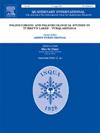Investigating Holocene relative sea-level changes and coastal dynamics in the mid-Tyrrhenian coast, Italy: An interdisciplinary study
IF 1.9
3区 地球科学
Q3 GEOGRAPHY, PHYSICAL
引用次数: 0
Abstract
Understanding millennial changes in relative sea level (RSL) and coastal responses in stable regions is crucial for deciphering the intricate relationship between natural dynamics and human adaptation. This interdisciplinary study explores the interplay between mid-to-Late Holocene sea-level fluctuations and tectonic along the mid-Tyrrhenian coast.
The study area, located between the Fondi and Garigliano coastal plains, held great significance in ancient times. In particular, the strategic role of Formia, a monitoring point for the Tyrrhenian Sea, made this city one of the most important commercial hub during Roman occupation, leading to a significant urbanization of the coastal stretch testified by well-preserved remains nowadays scattered along the submerged or semi-submerged coastal sectors.
This study reconstructs the mid-to-Late Holocene morpho-evolution and RSL changes in the study area by creating a geodatabase made of 52 sea-level markers (SLMs) derived from direct geoarchaeological measurements, stratigraphic and palaeoecological interpretations of new borehole data, and previously published stratigraphic data. Specifically, the radiocarbon dating of three peat samples provided new data ranging between 7.62 ± 47 and 1.00 ± 51 ka BP on the sea level history in the area. Based on our dataset, between 9.0 and 8.0 ka BP, the sea level rose from −19 m to −6.5 m at a rate of about 15.6 mm/y, slowing to 0.8 mm/y afterwards, stabilizing at its current position. Results suggest that during the 1st century BC, local sea level was no higher than −0.55 ± 0.29 m.
The collected RSL data support the hypothesis of tectonic stability of this sector during the last 2.0 ka, testified by the position of the SLMs in accordance with the glacio-hydro-isostatic adjustment (GIA) models and supported by the determination of average vertical ground movement rates of −0.017 ± 0.23 mm/y.
Finally, in terms of coastal changes the overlay between new data from geoarchaeological surveys, reinterpretation of previously-published stratigraphic data, and geomorphological analysis allowed us to deduce a general coastal progradation trend in the historical time for both low-lying and rocky sectors, due to natural and anthropogenic forcing factors.
调查意大利中泰勒尼安海岸全新世相对海平面变化和海岸动态:跨学科研究
了解相对海平面(RSL)的千年变化和稳定地区的海岸反应,对于解读自然动态与人类适应之间错综复杂的关系至关重要。这项跨学科研究探讨了中晚全新世海平面波动与中泰勒尼安海岸构造之间的相互作用。研究区域位于丰迪和加里利亚诺沿海平原之间,在古代具有重要意义。特别是福米亚作为第勒尼安海的监测点所发挥的战略作用,使这座城市在罗马占领时期成为最重要的商业中心之一,从而导致了沿海地带的显著城市化,如今散布在淹没或半淹没沿海地带的保存完好的遗迹证明了这一点。本研究通过建立一个由 52 个海平面标记(SLMs)组成的地理数据库,重建了研究区域全新世中期至晚期的形态演变和 RSL 变化,这些海平面标记来自直接地质考古测量、对新钻孔数据的地层学和古生态学解释,以及之前公布的地层数据。具体而言,三个泥炭样本的放射性碳年代测定为该地区的海平面历史提供了介于 7.62 ± 47 和 1.00 ± 51 ka BP 之间的新数据。根据我们的数据集,在公元前 9.0 至 8.0 ka 期间,海平面以约 15.6 毫米/年的速度从-19 米上升到-6.5 米,之后减缓到 0.8 毫米/年,并稳定在目前的位置。结果表明,在公元前 1 世纪,当地海平面不高于-0.55 ± 0.29 米。收集到的 RSL 数据支持了该地区在过去 2.0 ka 期间构造稳定的假说,SLM 的位置符合冰川-流体-等静力调整(GIA)模型,并得到了平均垂直地面运动速率为-0.017 ± 0.23 毫米/年的测定结果的支持。最后,在海岸变化方面,地质考古调查的新数据、对以前公布的地层数据的重新解释以及地貌分析的叠加,使我们能够推断出低洼地区和岩石地区在历史上由于自然和人为因素的影响而出现的总体海岸塌陷趋势。
本文章由计算机程序翻译,如有差异,请以英文原文为准。
求助全文
约1分钟内获得全文
求助全文
来源期刊

Quaternary International
地学-地球科学综合
CiteScore
5.60
自引率
4.50%
发文量
336
审稿时长
3 months
期刊介绍:
Quaternary International is the official journal of the International Union for Quaternary Research. The objectives are to publish a high quality scientific journal under the auspices of the premier Quaternary association that reflects the interdisciplinary nature of INQUA and records recent advances in Quaternary science that appeal to a wide audience.
This series will encompass all the full spectrum of the physical and natural sciences that are commonly employed in solving Quaternary problems. The policy is to publish peer refereed collected research papers from symposia, workshops and meetings sponsored by INQUA. In addition, other organizations may request publication of their collected works pertaining to the Quaternary.
 求助内容:
求助内容: 应助结果提醒方式:
应助结果提醒方式:


